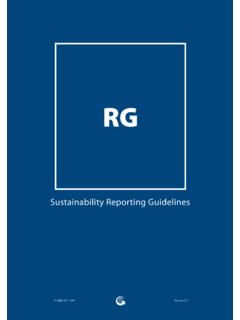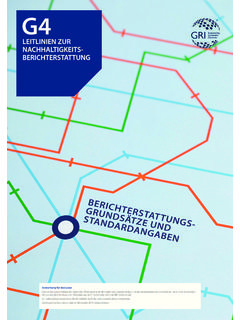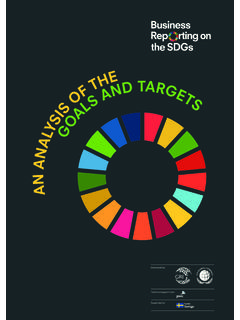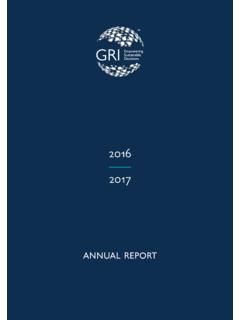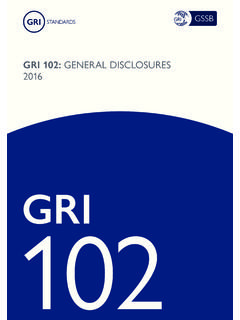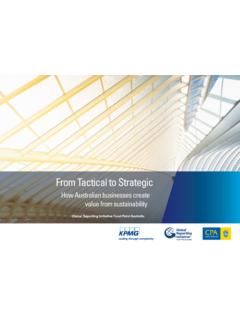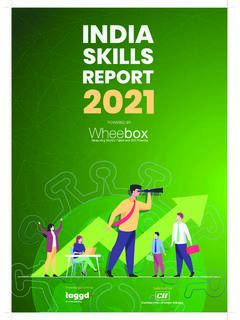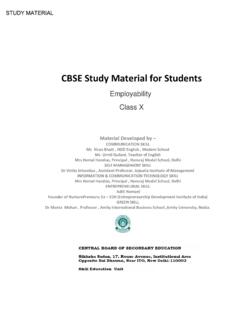Transcription of GRI 404: TRAINING AND EDUCATION 2016
1 gri 404 : TRAINING AND EDUCATION 2016 GRI 4042 gri 404 : TRAINING and EDUCATION 2016 ContentsIntroduction 3 gri 404 : TRAINING and EDUCATION 51. Management approach disclosures 52. Topic-specific disclosures 6 Disclosure 404-1 Average hours of TRAINING per year per employee 6 Disclosure 404-2 Programs for upgrading employee skills and transition assistance programs 8 Disclosure 404-3 Percentage of employees receiving regular performance and career development reviews 9 Glossary 10 References 12 ResponsibilityThis Standard is issued by the Global Sustainability Standards Board (GSSB). Any feedback on the GRI Standards can be submitted to for the consideration of the GSSB. ScopeGRI 404: TRAINING and EDUCATION sets out reporting requirements on the topic of TRAINING and EDUCATION . This Standard can be used by an organization of any size, type, sector or geographic location that wants to report on its impacts related to this referencesThis Standard is to be used together with the most recent versions of the following 101: FoundationGRI 103: Management Approach GRI Standards GlossaryIn the text of this Standard, terms defined in the Glossary are dateThis Standard is effective for reports or other materials published on or after 1 July 2018.
2 Earlier adoption is this Standard Note: This document includes hyperlinks to other Standards. In most browsers, using ctrl + click will open external links in a new browser window. After clicking on a link, use alt + left arrow to return to the previous 404: TRAINING and EDUCATION 2016A. Overview This Standard is part of the set of GRI Sustainability Reporting Standards (GRI Standards). These Standards are designed to be used by organizations to report about their impacts on the economy, the environment, and GRI Standards are structured as a set of interrelated, modular standards. The full set can be downloaded at There are three universal Standards that apply to every organization preparing a sustainability report:GRI 101: FoundationGRI 102: General DisclosuresGRI 103: Management Approach An organization then selects from the set of topic-specific GRI Standards for reporting on its material topics.
3 These Standards are organized into three series: 200 (Economic topics), 300 (Environmental topics) and 400 (Social topics). Each topic Standard includes disclosures specific to that topic, and is designed to be used together with GRI 103: Management Approach, which is used to report the management approach for the Using the GRI Standards and making claims There are two basic approaches for using the GRI Standards. For each way of using the Standards there is a corresponding claim, or statement of use, which an organization is required to include in any published materials. 1. The GRI Standards can be used as a set to prepare a sustainability report that is in accordance with the Standards. There are two options for preparing a report in accordance (Core or Comprehensive), depending on the extent of disclosures included in the report. An organization preparing a report in accordance with the GRI Standards uses this Standard, gri 404 : TRAINING and EDUCATION , if this is one of its material Selected GRI Standards, or parts of their content, can also be used to report specific information, without preparing a report in accordance with the Standards.
4 Any published materials that use the GRI Standards in this way are to include a GRI-referenced 404: TRAINING and EDUCATION is a topic-specific GRI Standard in the 400 series (Social topics).GRI 101: Foundation is the starting point for using the GRI Standards. It has essential information on how to use and reference the Section 3 of GRI 101: Foundation for more information on how to use the GRI Standards, and the specific claims that organizations are required to include in any published materials. GRI 103 GRI 102 Topic-specificStandardsUniversal StandardsStarting point for using the GRI StandardsGRI 101 FoundationGeneral DisclosuresManagement ApproachTo report contextual information about an organizationTo report the management approach for each material topicSelect from these to report specific disclosures for each material topicGRI 300 EnvironmentalGRI 400 SocialGRI 200 EconomicFigure 1 Overview of the set of GRI Standards4 gri 404 : TRAINING and EDUCATION 2016C.
5 Requirements, recommendations and guidance The GRI Standards include: Requirements. These are mandatory instructions. In the text, requirements are presented in bold font and indicated with the word shall . Requirements are to be read in the context of recommendations and guidance; however, an organization is not required to comply with recommendations or guidance in order to claim that a report has been prepared in accordance with the These are cases where a particular course of action is encouraged, but not required. In the text, the word should indicates a recommendation. Guidance. These sections include background information, explanations and examples to help organizations better understand the organization is required to comply with all applicable requirements in order to claim that its report has been prepared in accordance with the GRI Standards. See GRI 101: Foundation for more Background context In the context of the GRI Standards, the social dimension of sustainability concerns an organization s impacts on the social systems within which it operates.
6 gri 404 addresses the topic of TRAINING and EDUCATION . This includes an organization s approach to TRAINING and upgrading employee skills , and performance and career development reviews. It also includes transition assistance programs to facilitate continued employability , and the management of career endings due to retirement or termination. These concepts are covered in key instruments of the International Labour Organization and the Organisation for Economic Co-operation and Development: see References. The disclosures in this Standard can provide information about an organization s impacts related to TRAINING and EDUCATION , and how it manages these impacts. 5 gri 404 : TRAINING and EDUCATION 2016 This Standard includes disclosures on the management approach and topic-specific disclosures. These are set out in the Standard as follows: Management approach disclosures (this section references GRI 103) Disclosure 404-1 Average hours of TRAINING per year per employee Disclosure 404-2 Programs for upgrading employee skills and transition assistance programs Disclosure 404-3 Percentage of employees receiving regular performance and career development reviewsReporting The reporting organization shall report its management approach for TRAINING and EDUCATION using GRI 103: Management 404: TRAINING and Education1.
7 Management approach disclosuresManagement approach disclosures are a narrative explanation of how an organization manages a material topic, the associated impacts, and stakeholders reasonable expectations and interests. Any organization that claims its report has been prepared in accordance with the GRI Standards is required to report on its management approach for every material topic, as well as reporting topic-specific disclosures for those , this topic-specific Standard is designed to be used together with GRI 103: Management Approach in order to provide full disclosure of the organization s impacts. GRI 103 specifies how to report on the management approach and what information to 404: TRAINING and EDUCATION 2016 Disclosure 404-1 Average hours of TRAINING per year per employee2. Topic-specific disclosures Reporting requirements404 -1 DisclosureReporting When compiling the information specified in Disclosure 404-1, the reporting organization should: express employee numbers as either head count or Full Time Equivalent (FTE), and disclose and apply the approach consistently in the period, and between periods; use data from Disclosure 102-7 in GRI 102: General Disclosures to identify the total number of employees; draw from the information used for Disclosure 405-1 in GRI 405: Diversity and Equal Opportunity to identify the total number of employees by employee for Disclosure 404-1 This disclosure provides insight into the scale of an organization s investment in TRAINING , and the degree to which the investment is made across the entire employee the context of this Standard, TRAINING refers to: all types of vocational TRAINING and instruction.
8 Paid educational leave provided by an organization for its employees; TRAINING or EDUCATION pursued externally and paid for in whole or in part by an organization; TRAINING on specific does not include on-site coaching by supervisors. To calculate the information in Disclosure 404-1, the reporting organization can use the followingformulas:GuidanceThe reporting organization shall report the following information:a. Average hours of TRAINING that the organization s employees have undertaken during the reporting period, by: i. gender; ii. employee TRAINING hours per employee =Total number of TRAINING hours provided to employeesTotal number of employeesAverage TRAINING hours per female =Total number of TRAINING hours provided to female employeesTotal number of female employees7 gri 404 : TRAINING and EDUCATION 2016 A number of calculations can be undertaken to report on employee categories.
9 These calculations arespecific to each TRAINING hours per male =Total number of TRAINING hours provided to male employeesTotal number of male employeesAverage TRAINING hours per employee category =Total number of TRAINING hours provided to each category of employeesTotal number of employees in categoryDisclosure 404-1 Continued8 gri 404 : TRAINING and EDUCATION 2016 Disclosure 404-2 Programs for upgrading employee skills and transitionassistance programs Reporting requirements404 -2 DisclosureGuidanceGuidance for Disclosure 404-2 Employee TRAINING programs that aim to upgrade skills can include: internal TRAINING courses; funding support for external TRAINING or EDUCATION ; the provision of sabbatical periods with guaranteed return to assistance programs provided to support employees who are retiring or who have beenterminated can include: pre-retirement planning for intended retirees; retraining for those intending to continue working; severance pay, which can take into account employee age and years of service; job placement services; assistance (such as TRAINING , counselling) on transitioning to a non-working for upgrading employee skills allow an organization to plan skills acquisition that equipsemployees to meet strategic targets in a changing work environment.
10 More skilled employees enhance the organization s human capital and contribute to employee satisfaction, which correlates strongly withimproved performance. For those facing retirement, confidence and quality of work relations is improvedby the knowledge that they are supported in their transition from work to reporting organization shall report the following information:a. Type and scope of programs implemented and assistance provided to upgrade employee Transition assistance programs provided to facilitate continued employability and the management of career endings resulting from retirement or termination of 404: TRAINING and EDUCATION 2016 Disclosure 404-3 Percentage of employees receiving regular performanceand career development reviews Reporting requirements404-3 DisclosureGuidanceBackgroundThis disclosure measures the extent to which an organization regularly appraises employee performance. This aids the personal development of individual employees.
